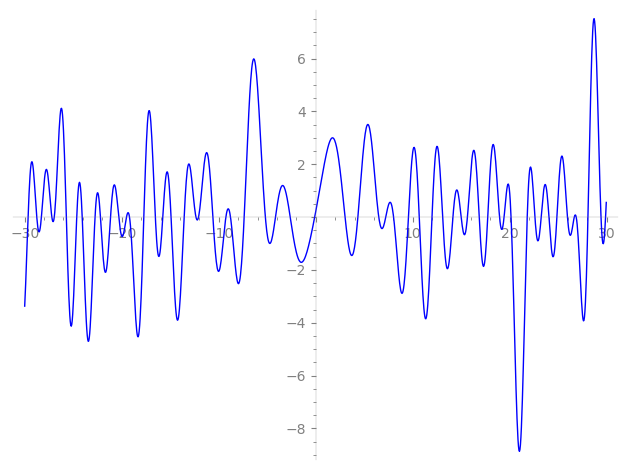| L(s) = 1 | − 2i·2-s + (2.12 + 2.12i)3-s − 4·4-s + (−11.8 − 11.8i)5-s + (4.24 − 4.24i)6-s + (−13.2 + 13.2i)7-s + 8i·8-s + 8.99i·9-s + (−23.6 + 23.6i)10-s + (0.845 − 0.845i)11-s + (−8.48 − 8.48i)12-s − 68.4·13-s + (26.4 + 26.4i)14-s − 50.2i·15-s + 16·16-s + (−59.0 − 37.7i)17-s + ⋯ |
| L(s) = 1 | − 0.707i·2-s + (0.408 + 0.408i)3-s − 0.5·4-s + (−1.05 − 1.05i)5-s + (0.288 − 0.288i)6-s + (−0.714 + 0.714i)7-s + 0.353i·8-s + 0.333i·9-s + (−0.748 + 0.748i)10-s + (0.0231 − 0.0231i)11-s + (−0.204 − 0.204i)12-s − 1.45·13-s + (0.505 + 0.505i)14-s − 0.864i·15-s + 0.250·16-s + (−0.842 − 0.538i)17-s + ⋯ |
\[\begin{aligned}\Lambda(s)=\mathstrut & 102 ^{s/2} \, \Gamma_{\C}(s) \, L(s)\cr =\mathstrut & (-0.901 - 0.431i)\, \overline{\Lambda}(4-s) \end{aligned}\]
\[\begin{aligned}\Lambda(s)=\mathstrut & 102 ^{s/2} \, \Gamma_{\C}(s+3/2) \, L(s)\cr =\mathstrut & (-0.901 - 0.431i)\, \overline{\Lambda}(1-s) \end{aligned}\]
Particular Values
| \(L(2)\) |
\(\approx\) |
\(0.0459533 + 0.202412i\) |
| \(L(\frac12)\) |
\(\approx\) |
\(0.0459533 + 0.202412i\) |
| \(L(\frac{5}{2})\) |
|
not available |
| \(L(1)\) |
|
not available |
\(L(s) = \displaystyle \prod_{p} F_p(p^{-s})^{-1} \)
| $p$ | $F_p(T)$ |
|---|
| bad | 2 | \( 1 + 2iT \) |
| 3 | \( 1 + (-2.12 - 2.12i)T \) |
| 17 | \( 1 + (59.0 + 37.7i)T \) |
| good | 5 | \( 1 + (11.8 + 11.8i)T + 125iT^{2} \) |
| 7 | \( 1 + (13.2 - 13.2i)T - 343iT^{2} \) |
| 11 | \( 1 + (-0.845 + 0.845i)T - 1.33e3iT^{2} \) |
| 13 | \( 1 + 68.4T + 2.19e3T^{2} \) |
| 19 | \( 1 + 5.36iT - 6.85e3T^{2} \) |
| 23 | \( 1 + (-26.9 + 26.9i)T - 1.21e4iT^{2} \) |
| 29 | \( 1 + (-40.7 - 40.7i)T + 2.43e4iT^{2} \) |
| 31 | \( 1 + (-41.3 - 41.3i)T + 2.97e4iT^{2} \) |
| 37 | \( 1 + (226. + 226. i)T + 5.06e4iT^{2} \) |
| 41 | \( 1 + (-218. + 218. i)T - 6.89e4iT^{2} \) |
| 43 | \( 1 + 281. iT - 7.95e4T^{2} \) |
| 47 | \( 1 - 274.T + 1.03e5T^{2} \) |
| 53 | \( 1 + 392. iT - 1.48e5T^{2} \) |
| 59 | \( 1 - 764. iT - 2.05e5T^{2} \) |
| 61 | \( 1 + (358. - 358. i)T - 2.26e5iT^{2} \) |
| 67 | \( 1 + 782.T + 3.00e5T^{2} \) |
| 71 | \( 1 + (785. + 785. i)T + 3.57e5iT^{2} \) |
| 73 | \( 1 + (-496. - 496. i)T + 3.89e5iT^{2} \) |
| 79 | \( 1 + (-558. + 558. i)T - 4.93e5iT^{2} \) |
| 83 | \( 1 - 646. iT - 5.71e5T^{2} \) |
| 89 | \( 1 + 385.T + 7.04e5T^{2} \) |
| 97 | \( 1 + (-1.13e3 - 1.13e3i)T + 9.12e5iT^{2} \) |
| show more | |
| show less | |
\(L(s) = \displaystyle\prod_p \ \prod_{j=1}^{2} (1 - \alpha_{j,p}\, p^{-s})^{-1}\)
Imaginary part of the first few zeros on the critical line
−12.34302636494515056049948119641, −12.08055160623598986783980051358, −10.60122400920014282260432519599, −9.259849521428599028895054523129, −8.785392921345086868746231705217, −7.37552339071660238947900966667, −5.19077391305736792903975923942, −4.14770038987384928941504022562, −2.62876793208126819816941993873, −0.10650488536020613552800096927,
3.02411305432723487295327035562, 4.34522611785397315568977101330, 6.49921262866970629537026130425, 7.21891887476946247683274485608, 8.025557409517394733547834316908, 9.554845376132833811033454317301, 10.67264938184714874532582176871, 11.98565271012604189312161936755, 13.08265456214107249362636860575, 14.14241788697765065590239357322

